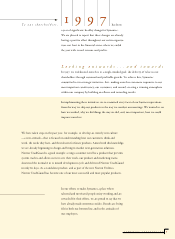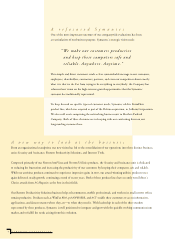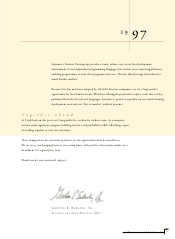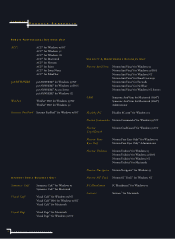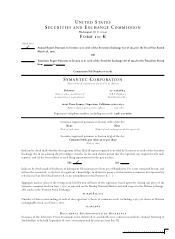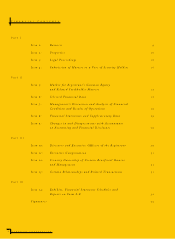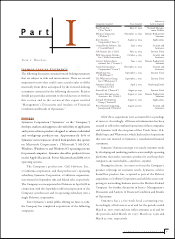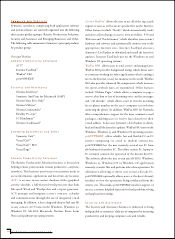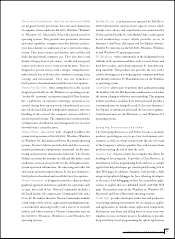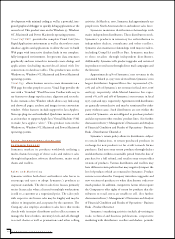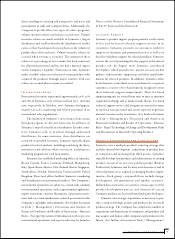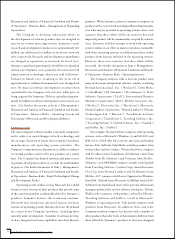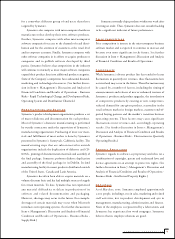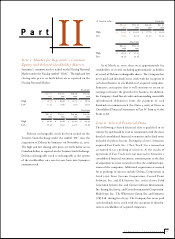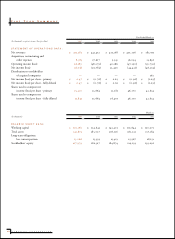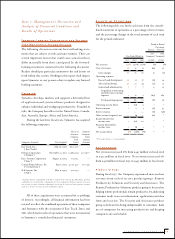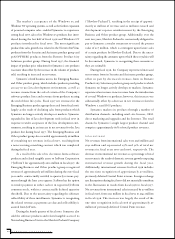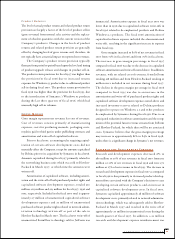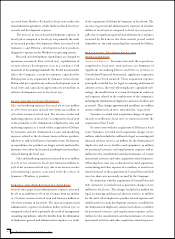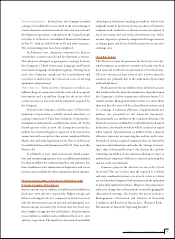Symantec 1997 Annual Report Download - page 15
Download and view the complete annual report
Please find page 15 of the 1997 Symantec annual report below. You can navigate through the pages in the report by either clicking on the pages listed below, or by using the keyword search tool below to find specific information within the annual report.
direct mailings to existing and prospective end users and
participation in trade and computer shows. Additionally, the
Company typically offers two types of rebate programs,
volume incentive rebates and rebates to end users. Volume
incentive rebates are made available to Symantec’s largest
distributors and resellers whereby the distributor or reseller
earns a rebate based upon their purchases or the volume of
product they sell to end users. Volume incentive rebates are
accrued when revenue is recorded. The amount of these
rebates as a percentage of net revenues has been consistent
for all periods presented and has not had a material impact
on the Company’s liquidity. From time to time, Symantec
makes available rebates to end users of various products who
acquired the products through major retailers. End user
rebates are accrued when revenue is recorded.
International Sales
International revenues represented approximately 29%, 32%
and 31% of Symantec’s net revenues in fiscal 1997, 1996 and
1995, respectively. At March 31, 1997, Symantec had approx-
imately 140 sales, marketing and related personnel in its
international sales organization.
The majority of Symantec’s net revenues from certain
European regions are derived from sales by affiliates of
Symantec’s major United States distributors. In other coun-
tries, Symantec sells its products through authorized
distributors. In some countries, these distributors are
restricted to specified territories. Symantec typically adapts
products for local markets, including translating the docu-
mentation and software where necessary, and prepares
marketing programs for each local market.
Symantec has established marketing offices in Australia,
Brazil, Canada, France, Germany, Holland, Hong Kong,
Italy, Japan, Korea, Mexico, New Zealand, Russia, Singapore,
South Africa, Sweden, Switzerland, Taiwan and the United
Kingdom. These local offices facilitate Symantec’s marketing
and distribution in international markets. The Company’s
international operations are subject to certain risks common
to international operations, such as government regulations,
import restrictions, currency fluctuations, repatriation restric-
tions and, in certain jurisdictions, reduced protection for the
Company’s copyrights and trademarks. (See further discussion
in Item 7: Management’s Discussion and Analysis of
Financial Condition and Results of Operations - Business
Risks - Foreign Operations.) Information with respect to
international operations and export sales may be found in
Note 12 of the Notes to Consolidated Financial Statements
in Part IV, Item 14 of this Form 10-K.
Customer Support
Symantec’s product support program provides a wide variety
of free and fee-based technical support services to its
customers. Symantec provides its customers with free
support via electronic and automated services as well as 90
days free telephone support for selected products. Symantec
accrues the cost of providing this free support at the time of
product sale. In August 1996, Symantec introduced
LiveUpdate, which provides free, instant access to on-line
updates, enhancements, support tips and other useful infor-
mation for selected products. In addition, Symantec offers
both domestic individual users and domestic corporate
customers a variety of fee-based options designed to meet
their technical support requirements. These fee-based
support programs are revised from time to time as customer
requirements change and as market trends dictate. Fee-based
technical support services did not generate material revenues
in any fiscal years presented and are not expected to generate
material revenues in the near future. (See further discussion
in Item 7: Management’s Discussion and Analysis of
Financial Condition and Results of Operations - Business
Risks - Rapid Technological Change and Development Risks
and Fluctuations in Quarterly Operating Results.)
Product Development and Acquisitions
Symantec uses a multiple products sourcing strategy that
includes internal development, acquisitions of product lines
or companies and licensing from third parties. Symantec
typically develops new products and enhancements of existing
products in one of its two core product groups (Remote
Productivity Solutions and Security and Assistance) and in
selected product areas targeted as emerging business oppor-
tunities. Each group’s responsibilities include design,
development, documentation and quality assurance.
Independent contractors are used for certain aspects of the
product development process and elements of certain
Company products are licensed from third-party developers.
Symantec uses strategic acquisitions, as necessary, to pro-
vide certain technology, people and products for its overall
product strategy. The Company has completed a number of
acquisitions and dispositions of companies and products and
may acquire and dispose other companies and products in the
future. (See further discussion in Item 7: Management’s
13
SYMANTEC CORPORATION


